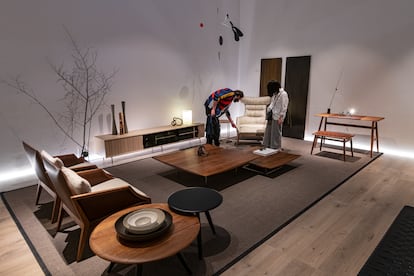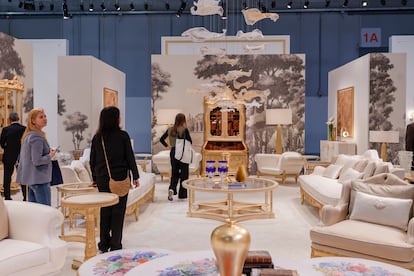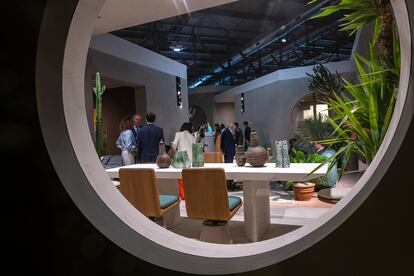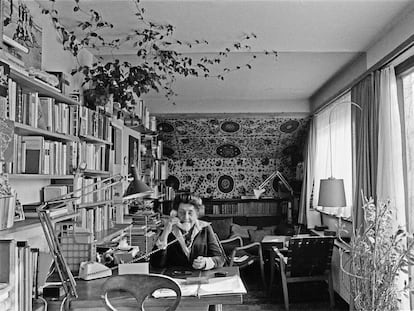Why Milan remains the undisputed design capital of the world
Salone del Mobile.Milano: the world’s largest furniture trade fair held a massive exhibition that took it to its limits and beyond

The of Salone del Mobile.Milano, the world’s largest furniture trade fair, closed its doors on its 61st exhibition last Sunday with the feeling that it had regained the usual buzz that the pandemic had stolen from it. Firstly, because it had returned to its usual April slot, after the 2022 fair was postponed to June in an attempt to mitigate the consequences of Italy’s health restrictions. But also because of its size and its aspiration to represent an entire industry that is essential for Italy. “What the Salone offers is the possibility of having the complete picture of the sector,” the fair’s president Maria Porro commented at a press conference on April 18, the opening day.
The fact that the inauguration was attended by top political representatives, including the Mayor of Milan Giuseppe Sala, and the Italian Prime Minister Giorgia Meloni, is an indication of the social and economic dimension the event has. The numbers back it up: with 2,000 exhibitors from 37 countries and 34% of foreign brands, it is an essential meeting point for the various players in the field: suppliers, designers, and end customers. The 25% increase in ticket sales compared to 2022 also confirmed the return of visitors from Asia and America, who were expected to bring the figures up to 300,000 attendees. And all this with the aim of unveiling the 2023 furniture and lighting collections of the leading brands in the sector.
Furniture design calls for its own, leisurely pace in Milan
The feeling among the exhibitors, whose spaces were conceived as large stores or showrooms, was one of creative calm and financial prosperity. Things are going well, as president of the FederlegnoArredo industry association, Claudio Feltri said at the inauguration. For two years, the Italian furniture industry has been growing at a rate in the double digits, driven by the real estate boom in Europe — especially in luxury housing — and also because the historic firms that specialized in luxury interior furnishings diversified their activity into two sectors: outdoor furniture — previously the exclusive preserve of specialized firms — and contract, i.e. creating custom-made furniture for restaurants, hotels, offices and residential projects. Hence the commercial collections, which were the ones on display at the Salone, were accentuated by a certain classicism this year. There were generously proportioned sofas, neutral tones and increasingly soft materials, large tables made of elegant materials — wood or stone — and solutions that allowed closets or storage areas to be infinitely enhanced. For the time being, the declarations of intent and the theatrical staging seemed to have settled down after the reissues of designs from the radical 1960s and 1970s that revitalized the sector before 2020.

The fair expanded into the Euroluce pavilions, dedicated to lighting, and Salone Satellite, given over to new designers. Spaniard Miguel Leiro used that platform to present a small collection with an almost avant-garde geometric language. The energy, however, was more diverse outside the fair, in the parallel activities and exhibitions that take place in different neighborhoods in Milan and that are part of Milan Design Week, whose prime mover is the Salone. Some firms took the opportunity to showcase their collections in historical sites: Poliform chose to exhibit in the famous cloister at the Faculty of Theology, and Armani Casa’s exhibition was at the palace that houses the company’s headquarters. Patricia Urquiola, the Spanish creative director of the historic Cassina store, presented her new sofa to the attendees. Finer, more durable and flexible materials replace the foam padding that has been common in the sector since the 1960s.

Convenience and sustainability are key factors in an industry that has with the wind at its back, but still needs a bit of risk to prevent it from resting on its laurels. Emerging and independent designers were grouped together in projects such as Alcova, in the city’s old slaughterhouse, or in pop-up spaces. Catalan Guillermo Santomà, a regular disruptor in the new experimental design, reinterpreted the rituals of wellness from a religious point of view in SPA, a disturbing installation halfway between a spa and a chapel.
Another Spaniard, Jorge Penadés, participated in Drop City, a group show in the old Milanese railway warehouses, with the exhibition that closed and summed up Extraperlo. For five years the project has gathered and marketed unique objects by the great names in design, created ad hoc and sold for more affordable prices. Previous shows were held in Madrid, but this time the collective decided to add the finishing touch in Milan. In view of the massive influx of people attending the events of this week, the city in Lombardy (Italy) has reaffirmed its undisputed title of world design capital for yet another year.
Sign up for our weekly newsletter to get more English-language news coverage from EL PAÍS USA Edition
Tu suscripción se está usando en otro dispositivo
¿Quieres añadir otro usuario a tu suscripción?
Si continúas leyendo en este dispositivo, no se podrá leer en el otro.
FlechaTu suscripción se está usando en otro dispositivo y solo puedes acceder a EL PAÍS desde un dispositivo a la vez.
Si quieres compartir tu cuenta, cambia tu suscripción a la modalidad Premium, así podrás añadir otro usuario. Cada uno accederá con su propia cuenta de email, lo que os permitirá personalizar vuestra experiencia en EL PAÍS.
¿Tienes una suscripción de empresa? Accede aquí para contratar más cuentas.
En el caso de no saber quién está usando tu cuenta, te recomendamos cambiar tu contraseña aquí.
Si decides continuar compartiendo tu cuenta, este mensaje se mostrará en tu dispositivo y en el de la otra persona que está usando tu cuenta de forma indefinida, afectando a tu experiencia de lectura. Puedes consultar aquí los términos y condiciones de la suscripción digital.
More information
Archived In
Últimas noticias
Welcome to the post-religion era: The idea of Christianity as the absolute truth has become obsolete
‘I thought you would like it’: The risky sexual practice popularized by TV shows and TikTok
The digitalization of tourism: ‘They promise experiences and gave us the worst possible one’
Mexican peso defies uncertainty with forecasts of a new period of stability in 2026
Most viewed
- Sinaloa Cartel war is taking its toll on Los Chapitos
- Reinhard Genzel, Nobel laureate in physics: ‘One-minute videos will never give you the truth’
- Oona Chaplin: ‘I told James Cameron that I was living in a treehouse and starting a permaculture project with a friend’
- Why the price of coffee has skyrocketed: from Brazilian plantations to specialty coffee houses
- Silver prices are going crazy: This is what’s fueling the rally











































